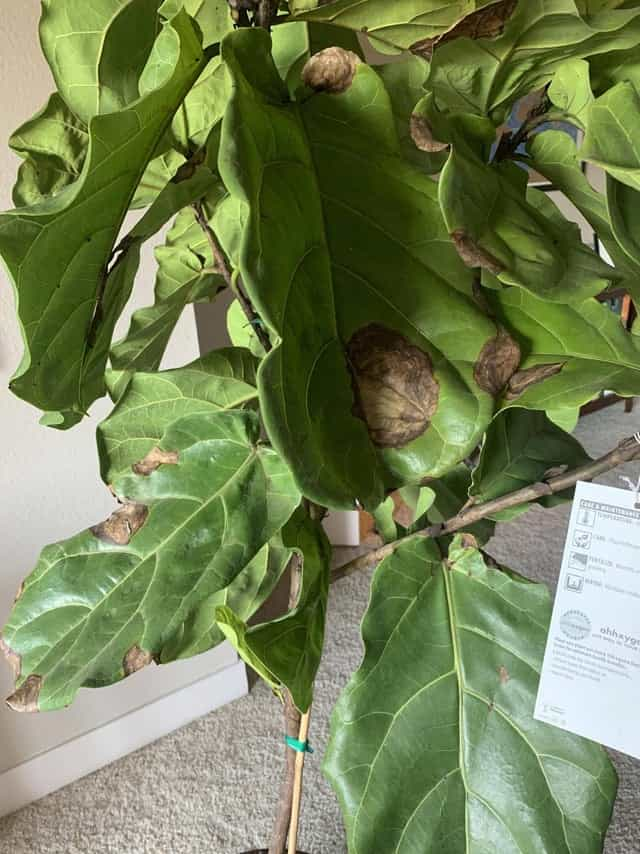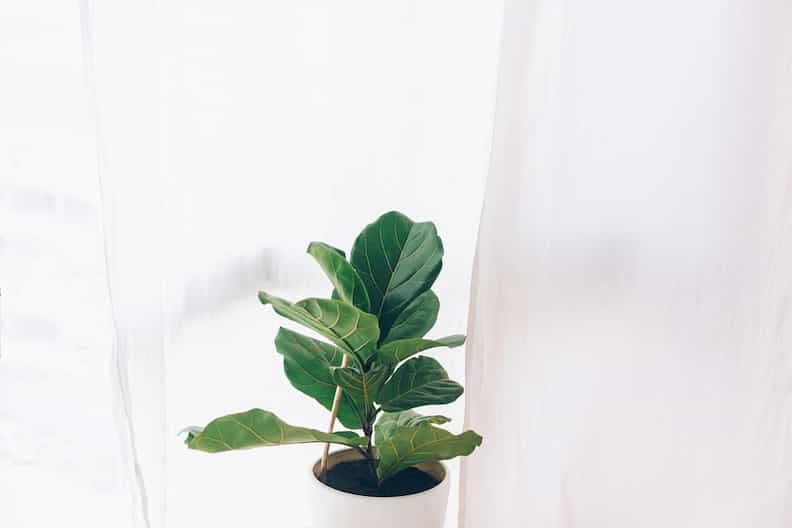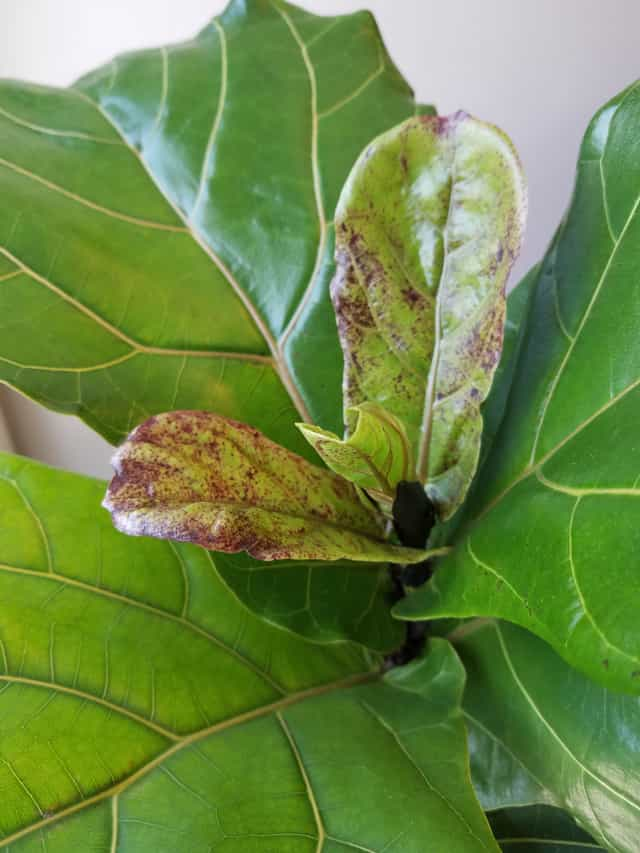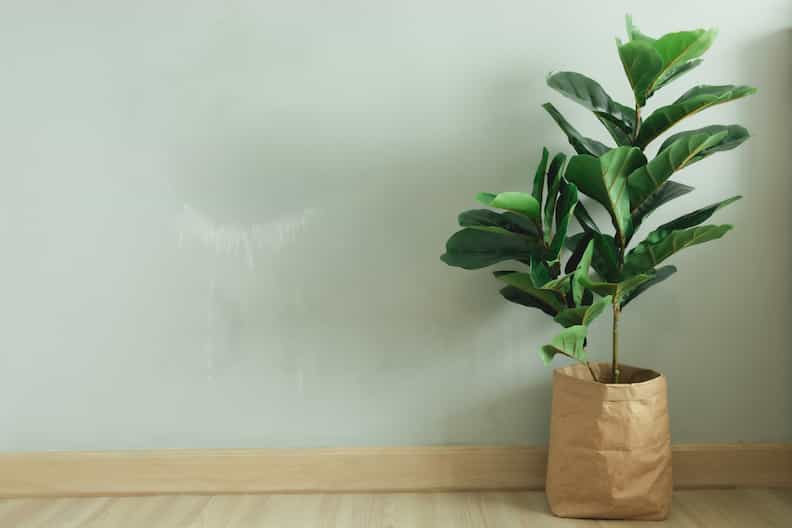I’ve always been a voracious indoor plant collector. To my mind, the greener my home, the better. So, imagine my horror when I noticed my fiddle leaf fig leaves turning brown.
In a heartbeat, these fiddle leaf fig brown spots became my obsession. Determined to figure out both cause and cure, I’ve done extensive research on how to identify, treat, and prevent brown spots from developing on a Ficus lyrata.
If you’ve just noticed the same on your Ficus, keep reading to find out just what you can do to get your plant back to its full green glory.

Table of Contents
What do brown spots on a fiddle leaf fig mean?
More often than not, brown spots on a fiddle leaf fig indicate an infection of some sort. Visible damage on the leaves of any plant occurs to warn you that something is amiss. If your fiddle leaf fig leaves start to turn brown, it means your plant is ill or distressed and needs intervention.
The good news is that none of the possible causes of your fiddle leaf fig’s brown spots is a death sentence for your plant. If caught early enough and treated urgently, there’s a very good chance your fiddle leaf will make a full recovery.
Usually, the cause of your fiddle leaf fig leaves turning brown is related to either an external or internal infection that is causing parts of your plant’s leaves to turn necrotic. In other words, plant tissue starts to die, turning leaves patchy and brown.

However, this is not the only reason fiddle leaf figs develop brown spots. They can also contract sunburn, which presents similarly to infections.
Illness that develops in fiddle leaf figs is generally directly related to its growing conditions. Fortunately, these can be easily adjusted if you know what to look out for. The first step is identifying the cause of brown spots on your fiddle leaf.
What causes a fiddle leaf fig to have brown spots?
There are a few primary reasons why a fiddle leaf fig might present with brown spots on its leaves. These include bacterial or fungal root rot, insect infestations, sunburn, or dryness. To narrow down your diagnosis, you can look at the spots’ location, color, and spread.
While fiddle leaf figs are relatively hardy, it’s advisable to keep an eye for any sign of illness. Brown spots on your fiddle leaf fig belie several possible ailments that may be afflicting your plant. If left untreated, you may end up with your fiddle leaf fig leaves falling off, which can permanently damage your plants’ health.
A close inspection of your leaves can help you identify the specific problem your plant is experiencing. The smell of your fig’s soil and the color, size, and spread of the brown spots can all give you more information about the issue at hand.
The cause of brown spots is mostly root rot, which can be either bacterial or fungal. However, insect infestations can also cause chaos on fiddle leaf figs. Sunburn and dryness are less likely culprits but are nevertheless sometimes the cause.
1. Bacterial root rot
Bacterial root rot presents as dark brown spots in irregular shapes towards the edge of your fig’s leaves. At later stages of infection, your leaves may also begin to crack where they’ve turned brown. Bacterial root rot results from overwatered or waterlogged soil, usually from poor drainage and a lack of aeration.
What makes it easy to identify is that the fiddle leaf fig’s brown spots usually start on the plant’s lower leaves, on older growth. At the beginning stages of a bacterial infection, a light, rust-colored area may appear on the underside of the plant’s leaves, meaning that you may think your fiddle leaf fig has red spots, not brown ones. No matter the color though, bacterial infections spread quickly and should be dealt with urgently.
2. Fungal root rot
Fungal root rot presents much the same way as bacterial root rot, except that the spots are usually darker, almost black. They also generally spread from the veins of leaves, usually more towards the center than the outer edges.
The cause of fungal root rot is the consequence of an overwatered fiddle leaf fig. Fungal spores develop in the plants’ soil, infecting the fig’s roots and causing them to perish. If the root system of your Ficus has turned brown and mushy, you can almost be assured your fiddle leaf fig has root rot.
3. Insect infestation
The presence of insects on a fiddle leaf fig can also cause brown spots to appear, but they are usually followed by tears or small holes in your fiddle leaf fig’s leaves. To diagnose an insect infestation, look for signs of small critters climbing over your plant or residual webs or eggs.
Dealing with an insect infection can be quite a simple process, as ridding yourself of the bugs and removing damaged leaf matter should sort out the problem. Insect spots are lighter in color than root rot spots and don’t spread by themselves.
4. Sunburn
If your indoor plant has suddenly been subjected to a large dose of sunshine, there’s a possibility that your fiddle leaf fig has sunburn. While this is not extremely common, it does happen and presents as light-tan colored spots on your plant’s top outer leaves.
Sunburnt areas can range from coin-sized to baseball-sized, depending on how much exposure the plant has experienced. Affected areas will not recover from the burn but can be removed without further damage to the plant.

5. Dryness
As with the soil in an overwatered fiddle leaf fig, overly dry soil can cause problems for fiddle leaf figs. They have huge leaves that require quite a bit of water and will suffer if they become dehydrated. Thirst is indicated by curling, droopy fiddle leaf fig leaves covered in large yellow or brown spots that feel crackly to the touch.
Typically, the spread of the brown discoloration begins at the edges of the leaves, moving inwards. Dehydration affects all leaves, not just a few, and is usually followed by your fiddle leaf fig’s leaves falling off.
To avoid this, make sure you learn (and follow!) about how often to water a fiddle leaf fig.
6. Leaf bruising or disease
When fiddle leaf figs have noticeably dark spots, it’s more than likely root rot, as this is the most common affliction that these plants experience. However, brown spots on your fiddle leaf fig may also result from leaf bruising (where a leaf has folded or cracked), or from a specific leaf-orientated disease, like bacterial leaf spot.
In the latter case, brown spots are usually an accompaniment to yellow leaves. The discoloration of the leaves is noticeable and precedes the brown spots that follow.
How do you treat fungus on a fiddle leaf fig?
To treat fungus on a Ficus, repot it to eradicate the infection and then remove as much of the plant’s diseased areas as possible. Fungi love dark, damp conditions and thrive in moist soil. Your first port of call is to change the fig’s soil and then treat it progressively as it recovers.
Fungal infections can be difficult to eliminate completely but changing your plant’s soil is always the best place to start. This is because fungi spores breed in soil, and the water absorbed by your fiddle leaf fig provides the perfect transportation vessel into its roots.
Start by gently removing your fiddle leaf from its existing pot. You’ll want to work in a clean, spacious area with tools that have been sterilized so that you don’t spread the infection further.

Wash off your plant’s roots, and if you notice that a number of them are rotten or necrotic, you will need to cut them away. Foul-smelling soil is also a dead giveaway. Try to untangle and spread out the root system where possible to allow air circulation around them.
Repot your fiddle leaf in fresh, good-quality, well-draining soil. Water it thoroughly and check to ensure it is, in fact, draining. Next, cut away infected areas of your plant (not more than 50% of the plant’s total circumference). For extra measure, treat your repotted tree with a bit of organic anti-fungal solution and put it somewhere with plenty of sun so your fiddle leaf fig’s light needs are being met.
How to treat a sunburnt fiddle leaf fig?
Treat sunburn by first removing your fiddle leaf from exposure to direct sunlight. Next, prune burnt leaves to prevent your plant from expending energy on trying to heal them. A bit of extra water and added humidity in the fiddle leaf’s growing environment can also help the plant recover.
At first glance, it may seem like sun damage only causes cosmetic damage to fiddle leaf figs. However, it can actually damage your plant’s health to quite a severe degree.
The big, waxy green leaves of the Ficus lyrata are quite susceptible to sun damage and shouldn’t spend too much time in direct, harsh sunlight. If you notice brown spots on the upper leaves of your fiddle leaf fig, this is your first indication that it needs to be moved or shaded.

If your fiddle leaf is sun-damaged, the best thing you can do for it is to remove the damage by pruning it away with sharp, sterilized shears. Burnt leaves will unfortunately not recover. If multiple leaves are harmed, remove only the most damaged ones, as removing too many can cause fatal distress.
Then, give your plant a little extra water and humidity to rehydrate its cells. Keep it in an east-facing window where it still gets 6 to 8 hours of daylight per day, but not the harsh direct light of the afternoon.
How do I get rid of brown spots on my fiddle leaf fig?
If your fiddle leaf fig leaves have brown spots, and they’re starting to drop from the plant, you need to act quickly to solve the issue. Without treatment, brown spots, which usually (but not always) result from root rot, can kill your Ficus in a matter of days.
Let’s look at how to get rid of brown spots on a fiddle leaf fig.
- Inspect your fig’s roots – Usually, brown spots result from a fungal or bacterial infection in your fiddle leaf fig. You need to inspect your plant’s roots to determine if root rot is the cause of the problem.
- Prune away decaying or necrotic roots – Once you’ve established if the root system of your fiddle leaf is unhealthy and in need of intervention, pull apart the root ball and eradicate any mushy or rotten roots.
- Test the integrity of your drainage system – Because fiddle leaf figs are so prone to root rot, you want to ensure they have excellent drainage. For an ill plant, make sure the drainage of its pot is sufficient to ensure no waterlogging occurs (gravel and plenty of drainage holes help).
- Replace the soil – The best soil for fiddle leaf figs is well-draining and well-aerated. If your plant has brown spots, repotting and refreshing its soil is almost always advisable.
- Removing damaged leaves – To help your plant recover and prevent brown spots from spreading, you need to remove leaves that are infected. If a leaf has gone more than 50% brown, it cannot be saved and should be cut away. That being said, don’t cut back more than 50% of your plant in total, potentially even leaving you with a fiddle leaf fig with no leaves, as it will take much longer to recover.
- Consider a root rot supplement – At your local garden center or nursery, you should be able to purchase a root rot supplement as an added preventative measure on your fiddle leaf’s road to recovery.
Should I remove brown leaves from my fiddle leaf fig?
Infected fiddle leaf fig leaves should be removed to prevent the spread of infection. They are unlikely to recover once they turn brown and become a waste of the plant’s energy. However, fiddle leaf figs are susceptible to shock, so you need to work gently to prevent further damage.
While fiddle leaf figs are hardy for the most part, they can be quite sensitive to extreme change. Therefore, before removing the fiddle leaf fig leaves that are turning brown, give it a thorough inspection to ensure you only cut away the bare minimum.

Bacterial and fungal infections need to be dealt with as a matter of urgency. Don’t leave them on your tree, or the infection will spread. This may mean quite a bare plant at the end of the day, but it’s also your tree’s best chance of recovery.
Furthermore, during the process of pruning your fiddle leaf fig, it’s most important that you use clean tools. Otherwise, you risk spreading infection from one part of the plant to another. Also, remember that the fiddle leaf will ooze a white sap when cut that is sticky and irritating to human skin.
How to avoid brown spots on a fiddle leaf fig?
There are a few preventive measures you can put in place to avoid brown spots on your fiddle leaf fig. Most of these are easy to achieve and will keep your plant in good health all year round.
- Avoid overwatering your fiddle leaf fig – Root rot is the main issue that afflicts fiddle leaf figs and turns their leaves brown. To avoid this, make sure you don’t overwater your plant or water it too frequently.
- Don’t underwater it either – Dryness can also cause brown spots, so don’t underwater your fiddle leaf fig. To test the moisture levels in its soil, insert your fingertip and feel if the top inch or so is damp.
- Ensure it has good drainage – Good drainage is essential for the Ficus lyrata. This is why the best planter for your fiddle leaf fig is one with well-spaced, sizable drainage holes at the bottom. Consider lining its base with gravel for extra distribution of excess moisture.
- Keep your fiddle leaf fig away from harsh direct sunlight – These gorgeous plants do love the sun, but they fare better in areas where the sunlight is from the east and isn’t too harsh or too bright. For indoor fiddle leaf figs’ light needs, a sunny east-facing window is ideal.
- Repot your fiddle leaf fig – Repotting your fiddle leaf figs every year or two will protect the integrity of their soil and keep them growing in relation to their planters. A fresh dose of soil can go a long way to keeping fungi at bay.
Will leaves grow back on a fiddle leaf fig?
Fiddle leaf figs will grow new leaves after pruning if they receive proper care and are situated in good growing conditions. They seldom grow back leaves in the same spots as they dropped or at the bottom of the plant. New growth commences from the top of the plant.
If your fiddle leaf fig fell a little bit ill, don’t fear. They can recover from illness and stress. Even if, at first, your fiddle leaf fig is not growing new leaves, you may just need to be a bit patient.
Fiddle leaves grow exceptionally large leaves, so it’s no surprise that they take a little while to get going. Naturally, the plant’s growing conditions will have a direct bearing on how well they recover, so be sure to give your Ficus a little extra TLC during this time.
Final thoughts on dealing with fiddle leaf fig leaves turning brown
When it comes to potential fiddle leaf fig problems, brown spots are definitely one of the more common ones. And as you can see, if your fiddle leaf fig leaves are turning brown, there are several possible causes.
That said, most of them are fairly easy to fix and with just a few tweaks to your regular plant care routine or slightly shifting the plant to a spot that keeps it happy and healthy, you should quickly start to see healthy leaves grow back on your fiddle leaf fig.
Of course, the earlier you notice any brown spots, the better it is for your plant. This is why it’s always good to just check in on your houseplant’s leaves from time to time, as they tend to be the best indicator of your plant’s overall health and can let you know if there are any issues that may require your attention.
